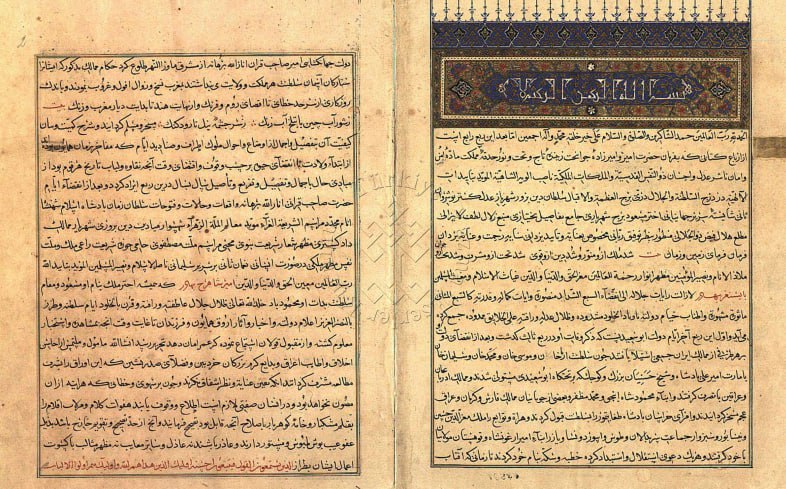Have you ever seen the world map created by our ancestors six centuries ago?

Imagine standing before a world map drawn in the 15th century. This is no ordinary map, but a vivid reflection of the intellectual and scientific potential of the Timurid era. This unique work belongs to the famous historian and geographer Hafizi Abru and is preserved within the pages of his book Geography.
Today, in the “Second Renaissance” section of the Museum of the Center of Islamic Civilization in Uzbekistan, alongside this masterpiece, another monumental work of the scholar Tarikh-i Hafizi Abru is also displayed.
The “golden pen” from Behadod
Hafizi Abru was born in 1361 in Behadod, in the Khawaf region of Khorasan. His full name was Mawlana Shihab al-Din Abdullah ibn Lutfullah ibn Abdurashid al-Bihdodi al-Khawafi, though he entered history under the name “Hafizi Abru”.
From an early age, he studied in Hamadan, mastering the Qur’an, hadith, tafsir, history, geography, literature, calligraphy, and engineering. These areas of knowledge later shone brightly in his historical and geographical works. Sources record that Hafizi Abru died on June 24, 1430.
Encounter with Amir Temur
It is known that during his campaigns, Amir Temur kept historians and narrators in his retinue to record history. Hafizi Abru caught the attention of the great commander during this process.
It is assumed that during Temur’s campaign in Khorasan and Iran in 1384, Hafizi Abru met him and entered his service. In his Zubdat al-Tawarikh, the scholar provides valuable information about Temur’s interest in history and the opportunities he created for historians.
Scientific legacy in the era of Shahrukh Mirza
After Temur’s death, Hafizi Abru continued his work in Herat under the rule of Shahrukh Mirza. There, he gained great recognition as a historian and geographer and led the circle of historians at the court.
Throughout his life, Hafizi Abru authored more than 10 works and treatises, leaving an indelible mark in historiography and geography, especially through Tarikh-i Hafizi Abru and Geography.
In Tarikh-i Hafizi Abru, events from ancient times up to his own day are covered, including dynasties, their founders, genealogies, and political affairs.
In the “Shahrukh Mirza Sector” of the “Second Renaissance” section, his Geography preserved at the Institute of Oriental Studies of the Academy of Sciences of Uzbekistan is also exhibited. This was the second major geographical work written in Persian, following Hudud al-‘Alam. This renowned historical-geographical text contains a circular world map as well as several regional maps. One of the most significant aspects of this world map is the inclusion of a degree grid, which geographers regard as Hafizi Abru’s magnum opus. The book details rivers, mountains, countries, and cities, as well as the geography and history of Fars, Kerman, Khorasan, and Transoxiana. It describes Samarkand, Bukhara, Kesh, Nakhshab, and Termez, as well as the Jayhun, Sayhun, and Murghab rivers, and provides measurements of distances and areas.
Notable works by Hafizi Abru
◾️Tarikh-i Hazrat Sahibqiran
◾️Tarikh-i Shahrukh Mirza
◾️Tarikh-i Amirayan-i Sarbadariya
◾️Majmu‘a-yi Hafizi Abru
◾️Majma‘ al-Tawarikh al-Sultaniyya
◾️The Zayl series
These works serve as essential sources for studying 15th-century Eastern historiography.
Modern significance of his scholarly legacy
Hafizi Abru did more than just record history he analyzed it and vividly conveyed the spirit of his time. His works are still preserved in libraries in St. Petersburg, Oxford, and Tashkent.
Today, the exhibition at the Center of Islamic Civilization in Uzbekistan presents the great scholar’s works to the public, offering a deeper understanding of the intellectual wealth of medieval Eastern civilization.
Hafizi Abru remains remembered as the “sultan” of Timurid historiography and an eternal symbol of knowledge and enlightenment.
Gavhar Eshonqulova
This article was prepared based on materials from the media project “Hafizi Abru and His Scholarly Legacy”, carried out within the framework of projects at the Center of Islamic Civilization in Uzbekistan.
Most read

More than 80 historical artifacts related to Uzbekistan are planned to be returned to our country

An extended meeting of the Scientific Council took place at the Center of Islamic Civilization

About a house even greater than the Kaaba...











